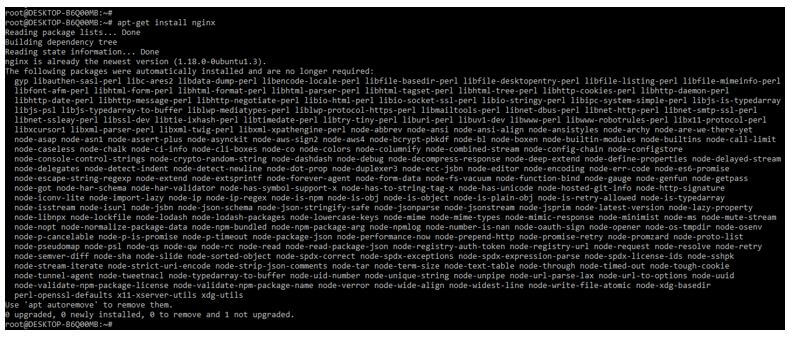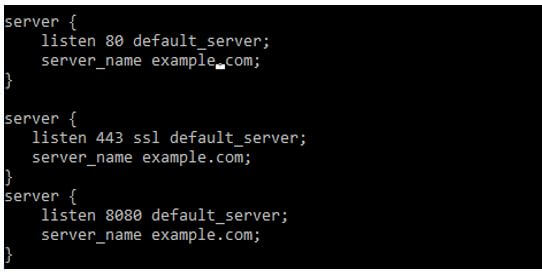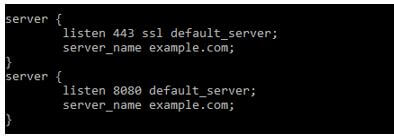Updated May 12, 2023
Introduction to Nginx default_server
Nginx default_server is nothing but the flag used to define the nginx server. In the nginx server block, when we are adding the flag of default_server into the directive of listen nginx server declaring the same as the default server. After declaring the default server, nginx will utilize the same as the default server for request handling at the time header of the http host will be unmatched from a block of the server.
What is Nginx default_server?
As a web server, the nginx server will permit us to define blocks of multiple servers in a configuration file of nginx. All the servers will be operating on the server of virtual machines. As a result of the approach, determining which server is handling specific requests is required. In the configuration file of nginx, we use default_server flat for this purpose. The flag of the default server is added once in a block of the server with the port combination, which was specified as a parameter for the directive listening from the nginx server.
How to Setup Nginx default_server?
We can utilize the default_server flag multiple times for the different IP port combinations.
Below steps shows how to set up the default server in nginx as follows:
1. First, we are installing an nginx server on our system. We are considering ubuntu as an environment. First, we install the nginx on our server in this step. We can install the nginx by using the following command.
Code:
apt-get install nginxOutput:
2. After installing the nginx server, we can check the nginx installed version by using the following command.
Code:
nginx –VOutput:
3. After installing the nginx server in this step, we edit the configuration file and add the default_server file. We know that in the configuration file of the nginx option of the default server, it specifies the client’s request by using an unknown domain, and it is forwarding the field of the empty host. For the specified instance, when a client writes the specified IP into a browser or multiple domains, we do not need to mention all of them in the configuration file. If suppose we have not added any parameter of default_server into the virtual server, then the first server is, by default, considered default_server. Also, we can explicitly define the default_server by using the following way as follows. After adding the flag of default_server in the configuration file, the nginx server is automatically defined as the default server.
Code:
server {
listen 80 default_server;
}Output:
4. When adding the default_server flag into the configuration file, we can also add another parameter of configuration, like the directory and the server’s name, which contains all the configuration files. The below example shows the following add the default_server parameter in the nginx configuration file. In the below example, we are adding the server_name parameter of default_server.
Code:
server {
listen 80 default_server;
server_name _;
root /nginx/html;
}Output:
5. After adding the default_server flag and its flag, we can check all the configuration options and their syntax by executing the below command. In the below example, we can see that after executing the command of nginx –t, the output will show the syntax of the configuration file is OK. Also, it will show if the configuration file test is successful.
Code:
nginx –tOutput:
Nginx default_server Parameter
The default_server parameter will define the default_server from which the client request is sent from which the host field contains the empty or domain that was unknown is defined in it. So, for example, we can say that when a client opens the server’s IP in the browser or the server contains several domains, we do not need to define all the domains in our configuration file.
Suppose by default we have not defined any default_server parameter; then the nginx server is considered first as the default server is the first which we have specified into the configuration.
The below example shows how we can define the default_server parameter in our configuration file as follows.
Code:
server {
listen 443 default_server;
}Output:
We can also define the server_name parameter using the default_server parameter.
Code:
server {
listen 8080 default_server;
server_name example.com;
}Output:
The example below defines the multiple default_server parameters in a single configuration file. We are using a different port for different default_server. In the below example, we have used the first server port as 80-second server port as 80, and the third server port as 8080.
Code:
server {
listen 80 default_server;
server_name example.com;
}
server {
listen 443 ssl default_server;
server_name example.com;
}
server {
listen 8080 default_server;
server_name example.com;
}Output:
Nginx default_server Configurations
In the configuration file of nginx, the block of the server will be specified as a virtual server that was used for handling the specified request. After sending the multiple server blocks, the nginx server chooses which blocks we need to use for the connection. The block selection is based on the port, request, IP address, and domain name.
We can also specify the nginx default_server configurations for handling the incoming request of the nginx server. For example, in the below nginx default_server configuration, we are using two blocks to define the nginx default server configuration.
Code:
server {
listen 443 ssl default_server;
server_name example.com;
}
server {
listen 8080 default_server;
server_name example.com;
}Output:
We can also add the directive of multiple default_server directives into the nginx configuration file. The listen directive into the configuration block is used to add the port and IP addresses used to listen to the request. We can use IPV4 and IPV6 addresses inside the square brackets. Our nginx default server configuration file should contain one directive for defining the virtual server.
Conclusion
As a web server, the nginx server will permit us to define blocks of multiple servers in a configuration file of nginx. For example, in the nginx server block, we are adding the flag of default_server into the directive of listen nginx server declaring the same as the default server.
Recommended Articles
This is a guide to Nginx default_server. Here we discuss the introduction and how to set up Nginx default_server with parameters and configurations. You may also have a look at the following articles to learn more –










